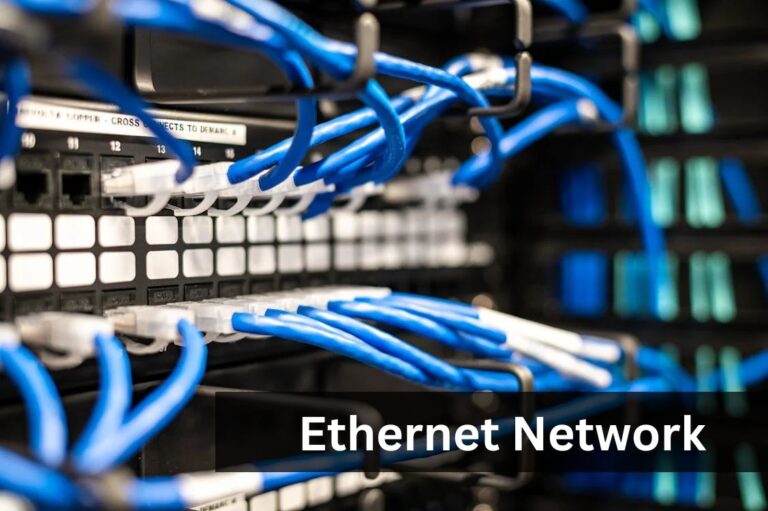Summary: Planning and designing the layout for your Ethernet network means you need to understand how all those devices link up. You have to pick the right hardware that fits. Then, map it all in a diagram that’s straightforward to follow. Get it done that way, and the network keeps running quickly. It stays secure and is set up to expand when you need it to.

In the wide sense, setting up an Ethernet network may sound simple, but it is easy to get it wrong if one has ever dealt with tangled cables and slow connections. Basically, a good network is not just about plugging in the devices, but about how one plans for everything to communicate with each other.
This is where an Ethernet network diagram comes in. It is an extremely straightforward map of your network showing how switches connect to servers and workstations, so that you avoid headaches and disorganization while at the same time keeping your network poised to expand with your business.
Before touching a cable or deciding on the kind of hardware to purchase, one must know what an Ethernet network layout really means. Think of it as the blueprint of your digital workspace, with every connection, device, and path mapped out for easy communication.
An Ethernet network diagram is an illustration that explains the physical and logical affiliations between the devices of a Local Area Network (LAN). It shows how computers, servers, switches, routers, and other things link up to each other, thus providing a clear ground perspective of the structure of the network.
A well-made network diagram is more than just a pretty picture or drawing. It is one of the instruments to help you manage your network in the following ways:

Before you start buying hardware and running cables, it’s critical to follow a structured approach.
Understanding your organizational needs is the foundation of a reliable network.
The topology dictates how devices communicate and affects network performance and reliability. Common Ethernet topologies include:
Topology | Description | Advantages | Disadvantages |
Bus | All devices share a single communication line | Cost-effective, simple layout | Collisions possible, limited scalability |
Star | Devices connect to a central hub or switch | Easy troubleshooting, scalable | Central hub failure affects network |
Ring | Devices connected in a circular fashion | Reduces collisions, predictable data flow | One device failure can disrupt network |
Mesh | Every device connected to multiple others | High redundancy, reliable | Expensive, complex cabling |
For most modern Ethernet networks, star and mesh topologies are preferred due to their reliability and scalability.
Your hardware choices define how well your network performs:
Component | Purpose | Recommended Standard/Cable |
Router | Directs data between networks | Layer 3, Gigabit or higher |
Switch | Connects devices within a LAN | Layer 2 or Layer 3, managed switch |
Cabling | Transmit data reliably | Cat5e (1 Gbps), Cat6/Cat6a (10 Gbps) |
Firewall | Network security | Dedicated appliance or virtual firewall |
Choosing high-quality Cat6 or Cat6a cables ensures future-proofing and high-speed connectivity.
Planning device placement and cabling is crucial for efficiency and troubleshooting:
Proper layout reduces maintenance time and prevents network downtime caused by tangled or mismanaged cables.
Downtime is expensive. Redundancy ensures your network keeps running:
Strategy | Purpose | Notes |
Redundant Links | Prevent single points of failure | Multiple uplinks for critical devices |
UPS (Uninterruptible Power) | Maintain uptime during outages | Centralized UPS for server rooms |
Backup Systems | Ensure data & config recovery | Schedule automated backups |
Network Monitoring & Alerts | Detect anomalies early | Tools like Auvik or SolarWinds |
Adding redundancy safeguards critical services and improves reliability, especially in business-critical networks.
Documentation is often overlooked, yet essential for long-term network health:
Aspect | Physical Diagram | Logical Diagram |
Shows Hardware | ✅ | ❌ |
Shows Data Flow | ❌ | ✅ |
Includes Cables | ✅ | Sometimes, optional |
Purpose | Installation & maintenance guidance | Planning, routing, and troubleshooting |
A good network is not just about connecting devices; it’s about following proven strategies to ensure long-term success.
Some of the standards to consider include IEEE 802.3 and TIA/EIA-568. Installations are interoperable with one another with a reliable performance, given cable types used and configuration are chosen correctly. For example, use Cat6a cables for 10 Gbps links to prepare your network for future uses.
Complex designs are hard to manage. Keep layouts straightforward to make troubleshooting and upgrades easier. A star topology is wonderful because it isolates faults easily and allows cleaning up of cabling.
Networks constantly change. Keep diagrams up-to-date as new devices appear, configurations change, or some equipment disappear. A number of tools- MyDraw, or Figma templates to name a couple- make it visual and straightforward to update diagrams.
Your network is only as strong as the team managing it. Make sure the employees in charge of IT know the system layout, the protocols, and how to troubleshoot it. Training cuts down on down times commonly caused by frequent errors.
Monitoring tools give a good view of the events occurring at any moment in terms of performance, bandwidth usage, and device health. Alerts for unusual activity ensure a swift response and prevent some costly outages.
Your network should grow along with your business. Modular switches, extra patch panel capacity, and cloud integration options make scaling a breeze and without any questionable major overhauls.
A good, strong Ethernet network diagram is like the backbone of your office tech: everything else depends on it being sound. When the network is planned out and set up most thoughtfully, devices communicate efficiently; downtime is at a minimum; and your team actually gets work done rather than wrestling with abysmal connection speed or random dropping of signals here and there. A good network layout also makes future upgrading, expansion, or troubleshooting that much easier.
Let us help you with planning and executing your entire office ethernet network layout. Network Drops have been connecting networks for decades and we take pride in adding more success stories to our list.
A physical network diagram displays hardware devices and their connections, while a logical network diagram gives an idea of data flows and network structure without reference to physical locations.
It is best to update your network diagram when some specific changes take place. It can include adding new devices, changing configurations or even upgrading the hardware.
Yes, several free tools are available, including MyDraw, Lucidchart, and Microsoft Visio, which offer templates and features for creating ethernet network diagrams.
Virtual Local Area Networks (VLANs) divide networks into segments like smaller, isolates subnets, increasing security and reducing in traffic of broadcast.
Plan for future growth by selecting scalable hardware, implementing modular designs, and considering cloud integration options.
"*" indicates required fields
Scott Fcasni is the driving force behind Shock I.T. Support’s commercial datacomm cabling division, delivering expert solutions that power reliable, high-performance network infrastructures. With extensive experience in structured cabling and a commitment to precision, Scott ensures that every project—whether for small businesses or large enterprises—meets the highest standards of quality and scalability.